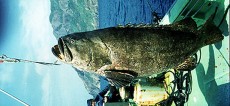|

|

|
Scientific Name: Epinephelus lanceolatus
Nomenclater: (Bloch, 1790)
Family: F338 Serranidae
Holotype-Locality: Indian Ocean
Habitats: Coral、Coastal
Economic Fish: Yes
Habitats Depth: 0 - 30 M
Aquarium Fish: Yes
Poisonous Fish: No
Edible Fish: Yes
Synonyms: Batrachus gigas, Holocentrus lanceolatus, Oligorus goliath, Oligorus terrae-reginae, Promicrops lanceolatus, Serranus abdominalis, Serranus geographicus, Serranus lanceolatus, Serranus phaeostigmaeus, Stereolepoides thompsoni
Reference: Shao & Kuo (1999)、Fishes of the Great Barrier Reef and Coral Sea(Randall et al.,1990), FAO species catalogue. vol. 16. Groupers of the world. Randall, J. E., G. R. Allen etc. 1990 Heemstra, P.C. etc. 1993 Kuo, S.-R. etc. 1999 文獻
Redlist Status: IUCN Redlist: Vulnerable(VU) IUCN Group
Common Name in Engulish: Queensland grouper; Queensland groper; Bridlebass; Brindlebass; Brindle grouper; Brindle bass; Giant grouper
Chinese Name transliteration: an dai shih ban yu, long dan shih ban, guo yu
Distribution in Taiwan: East
Distribution in World: India Ocean to Pacific Ocean
Max Lenth: 270 cm
Specimen List: ASIZP0058331. Download 1 records Download 1 records
Characteristic: Dorsal fin with XI spines and 14 to 16 rays, the 3rd to 11 th spines subequal, their length contained 3.1 to 5.7 in head length and much shorter than longest rays in adults; anal fin with III spines and 8 rays; pectoral-fin rays 18 to 20; pectoral-fin length contained 1.8 to 2.2 times in head length;pelvic fins not eaching anus, their length contained 2.1 to 2.6 times in head length: caudal fin rounded. Lateral-body scales smooth, with auxiliary scales; lateral-line scales 54 to 62, the anterior scales with branched tubules (except small juveniles); lateral-scale series 95 to 105.
Habitats: The largest bony fish found in coral reefs. Common in shallow waters. Found in caves or wrecks; also in estuaries. Individuals more than a meter long have been caught from shore and in harbors. Juveniles secretive in reefs and rarely seen. Feeds on spiny
Distribution: Indo-Pacific: Red Sea to Algoa Bay, South Africa and eastward to the Hawaiian and Pitcairn islands, north to southern Japan, south to Australia. Absence in the Persian Gulf is puzzling.
Utility: E. lanceolatus is not common enough to be of commercial importance, but it is often the target of spear-fishermen because of its size.
Text and images are provided by The Fish Datebase of Taiwan (Biodiversity Research Center, Academia Sinica, Taiwan)
|